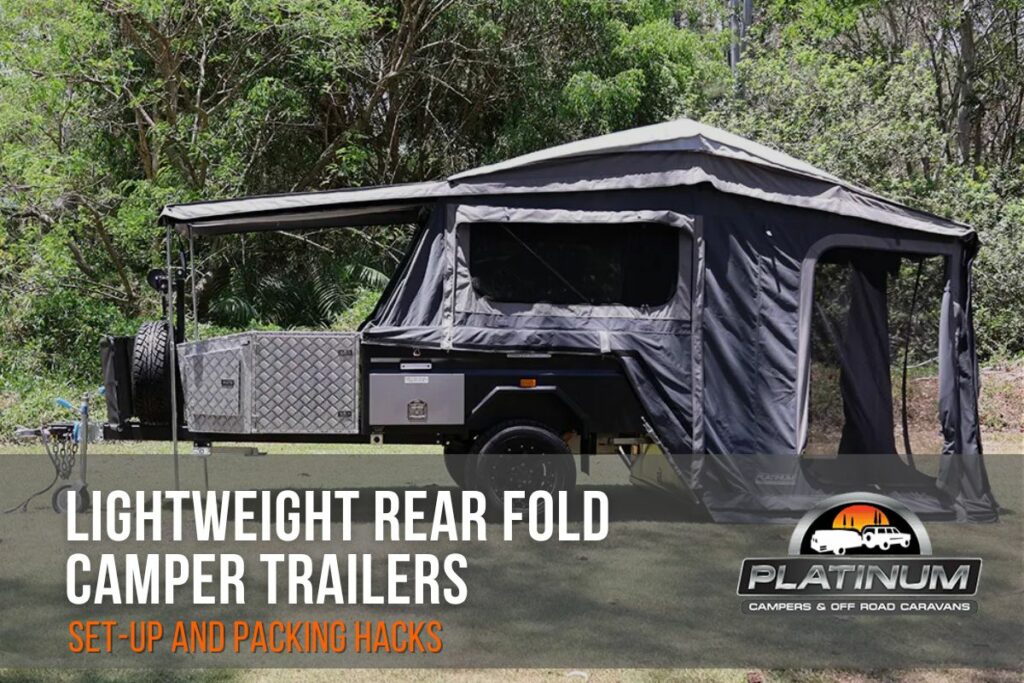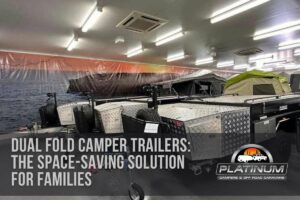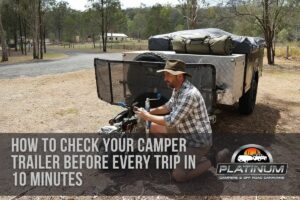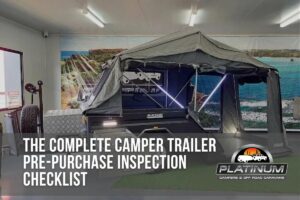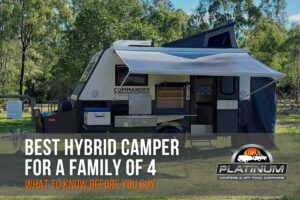Lightweight rear fold camper trailers have revolutionised the Australian camping experience, offering the perfect balance of quick setup, compact towing, and comfortable accommodation. These innovative designs feature a rear-opening mechanism that transforms your camper from a compact travel package into a spacious outdoor home in minutes. Whether you’re navigating the rugged terrain of Cape York or setting up camp beside a pristine Victorian lake, mastering the setup and packing techniques for your rear fold camper can dramatically enhance your camping efficiency and enjoyment.
Platinum Campers’ rear fold models, including the Chase S5 and Quest E1, exemplify Australian engineering excellence with their robust construction, thoughtful design, and user-friendly operation. These campers are specifically engineered to handle Australia’s diverse camping conditions while maintaining the lightweight characteristics that make them suitable for a wide range of towing vehicles.
Overview
This comprehensive guide will transform your camping efficiency with proven setup and packing strategies specifically designed for lightweight rear fold camper trailers. You’ll discover professional techniques for rapid deployment, space-maximising packing methods, and maintenance practices that ensure your camper performs reliably across Australia’s demanding landscapes.
We’ll explore everything from pre-departure preparation and systematic setup procedures to clever storage solutions and seasonal packing adaptations. Whether you’re a first-time camper owner or an experienced adventurer looking to optimise your camping routine, these expert insights will save you time, reduce stress, and maximise your outdoor enjoyment.
Key Takeaways
• Master the 15-minute setup routine that gets you camping faster
• Learn space-saving packing techniques that maximise storage capacity • Discover maintenance hacks that prevent common setup issues
• Understand weight distribution principles for safer towing
• Implement seasonal packing strategies for year-round adventures
• Use professional organisation systems that streamline your camping experience
• Apply troubleshooting techniques for common rear fold challenges
Understanding Lightweight Rear Fold Camper Design
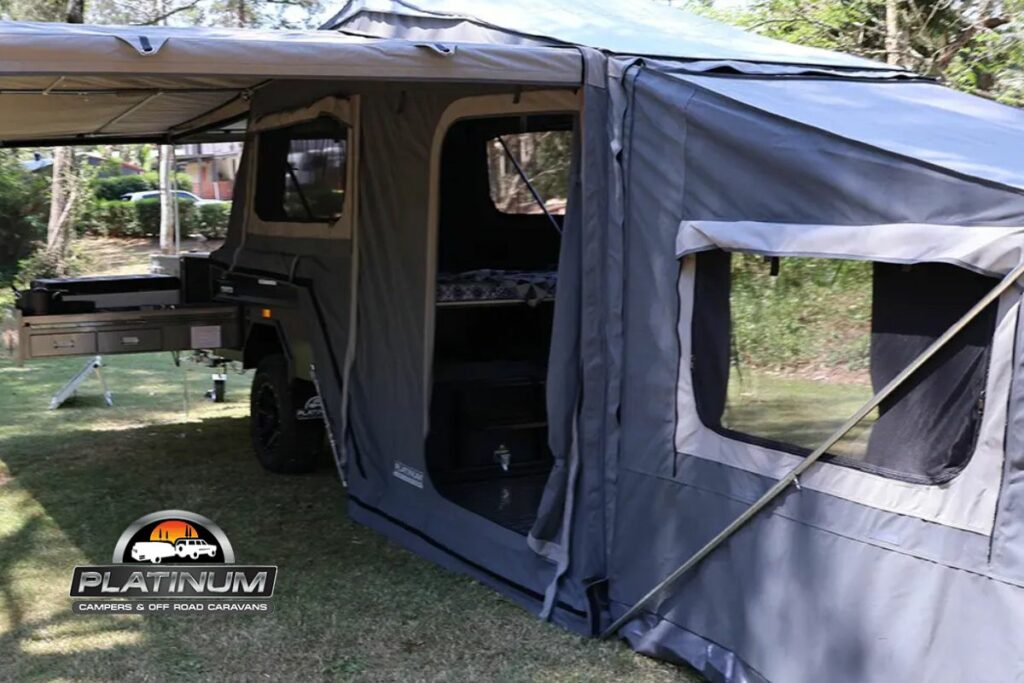
The Engineering Advantage
Lightweight rear fold camper trailers represent a significant advancement in camping technology, combining the durability of hard floor construction with the convenience of rapid deployment. The rear fold mechanism operates on a proven hinge system that allows the camper body to unfold backwards, creating a large sleeping and living area while maintaining structural integrity.
The design philosophy behind rear fold campers prioritises accessibility and efficiency. Unlike traditional forward fold models, rear fold campers position the main living area away from the towing vehicle, providing better privacy and easier access to the camper’s interior. This configuration also allows for more efficient packing, as the kitchen and storage areas remain easily accessible even when the camper is partially set up. For a detailed comparison of these design approaches, explore our forward fold vs rear fold comparison guide.
Australian manufacturers like us Platinum Campers have refined this design specifically for local conditions. The lightweight construction doesn’t compromise on durability, with heavy-duty chassis, independent suspension systems, and all-terrain capabilities that handle everything from beach sand to rocky mountain tracks.
Key Components and Their Functions
Understanding your rear fold camper’s components is essential for efficient setup and maintenance. The main hinge mechanism forms the backbone of the system, typically featuring heavy-duty steel construction with sealed bearings that resist dust and moisture. Gas struts assist with the lifting process, reducing the physical effort required while providing controlled deployment.
The canvas system integrates seamlessly with the hard floor sections, using a combination of zippers, velcro, and tensioning systems to create a weatherproof seal. Quality rear fold campers feature colour-coded setup instructions and numbered attachment points that streamline the assembly process.
Storage compartments are strategically positioned throughout the camper, with external hatches providing access to frequently used items without requiring full setup. This thoughtful design allows you to access camping essentials like chairs, cooking equipment, and basic supplies even during brief stops.
Pre-Departure Preparation and Organisation

Creating Your Setup Kit
Successful camper setup begins long before you reach your destination. Creating a dedicated setup kit containing all necessary tools and equipment ensures you’re never caught unprepared. Your setup kit should include adjustable spanners, cable ties, replacement springs, canvas repair patches, and a comprehensive first aid kit.
Invest in a high-quality LED headlamp and backup lighting for setups in low-light conditions. Include a portable air compressor for adjusting tyre pressures after off-road sections, and pack a basic toolkit specifically for camper maintenance. Many experienced campers also carry spare gas struts and hinge lubricant for unexpected maintenance needs.
Consider seasonal additions to your setup kit. Summer camping requires additional shade solutions and cooling accessories, while winter adventures demand extra insulation materials and heating equipment. Organise these items in clearly labelled containers that stack efficiently in your vehicle’s storage areas.
Strategic Packing Methods
Effective packing transforms your camping experience from chaotic to seamless. Begin with a comprehensive packing list that categorises items by frequency of use and setup priority. Essential items needed for immediate setup should be easily accessible, while long-term storage items can occupy less convenient spaces.
Utilise the camper’s multiple storage compartments strategically. Heavy items like water containers and cooking equipment should be positioned low and central to maintain optimal weight distribution. Lighter items such as clothing and bedding can occupy higher storage areas without affecting towing stability.
Implement a colour-coding system for storage containers and bags. This visual organisation method dramatically reduces setup time and prevents the frustration of searching through multiple containers for specific items. Many successful campers use clear storage containers with weatherproof seals to protect contents while maintaining visibility.
Master the 15-Minute Setup Routine
Step-by-Step Setup Sequence
Professional campers understand that efficient setup follows a specific sequence that maximises efficiency while ensuring safety. For those wondering about setup timeframes, most experienced users can complete the process in under 20 minutes. Begin by positioning your camper on level ground, using a bubble level to confirm proper alignment. Engage the handbrake and position wheel chocks to prevent accidental movement during setup.
The initial phase involves unhitching the camper and positioning stabiliser legs at all four corners. Modern rear fold campers feature adjustable legs with large footpads that distribute weight effectively across various ground conditions. Extend legs gradually, checking level frequently to avoid placing excessive stress on the camper frame.
Next, unlock the rear fold mechanism and begin the unfolding process. Gas struts will assist with the lifting, but maintain control throughout the operation. Most quality campers unfold smoothly with minimal effort, but be prepared to pause if resistance is encountered. Never force the mechanism, as this can damage critical components.
Canvas Attachment and Tensioning
Canvas attachment represents the most technical aspect of rear fold setup, but systematic approach makes it straightforward. Begin with the rear section, attaching corner grommets to their designated anchor points. Work progressively around the perimeter, maintaining even tension to prevent stress concentration.
Modern rear fold campers feature intuitive attachment systems with colour-coded components and numbered sequences. Follow the manufacturer’s specific instructions, as deviating from the recommended procedure can result in poor fit and potential damage. Pay particular attention to zipper alignment, ensuring smooth operation before fully tensioning the canvas.
Proper tensioning creates a weatherproof seal while preventing canvas damage from excessive stress. The canvas should be taut but not overstretched, allowing for natural material movement in changing weather conditions. Many experienced campers perform a final tension check after 30 minutes, as canvas materials often settle slightly after initial setup.
Interior Configuration and Final Checks
Interior setup should follow a logical progression that maximises space efficiency. Begin with the sleeping area, positioning mattresses and bedding first to establish your primary comfort zone. Modern rear fold campers offer various bed configuration options, from large double beds to separate single arrangements for families.
Kitchen setup comes next, with most rear fold campers featuring slide-out kitchen systems that provide excellent cooking facilities. Ensure gas connections are secure and test all appliances before beginning meal preparation. Position cooking equipment and utensils for easy access while maintaining safety clearances from canvas walls.
Complete your setup with a thorough safety inspection. Check all guy ropes and tensioning systems, verify that zippers operate smoothly, and confirm that all storage hatches secure properly. This final inspection identifies potential issues before they become problems, ensuring a safe and comfortable camping experience.
Space-Maximising Packing Techniques
Vertical Storage Solutions
Maximising storage capacity in lightweight rear fold campers requires thinking in three dimensions. Vertical storage solutions dramatically increase available space while maintaining organisation and accessibility. Install mesh organizers on interior walls to hold lightweight items like toiletries, phone chargers, and first aid supplies.
Hanging storage systems work particularly well in rear fold campers, as the increased interior height provides ample vertical space. Use over-door organisers on storage hatches to hold frequently accessed items, and consider magnetic strips for metal utensils and tools. These solutions keep essentials visible and accessible while freeing up valuable floor and counter space.
Stackable storage containers optimise space efficiency in external storage compartments. Choose containers with interlocking designs that prevent shifting during travel. Label each container clearly and maintain an inventory list to avoid unpacking multiple containers when searching for specific items. Many successful campers photograph their packed storage areas, creating visual references that speed up repacking at the end of trips.
Weight Distribution Principles
Proper weight distribution affects both towing safety and camper performance. The general rule places 60% of total weight forward of the camper’s axle, with heavy items positioned as low as possible to lower the centre of gravity. Water tanks, batteries, and cooking equipment should occupy the lowest available storage positions.
Distribute weight evenly from side to side to prevent lateral instability during cornering and crosswind conditions. Avoid concentrating heavy items on one side of the camper, as this creates handling challenges and increases tyre wear. Many experienced campers use bathroom scales to weigh individual storage areas, ensuring balanced loading.
Consider seasonal weight variations when planning your packing strategy. Winter camping typically requires additional clothing, heating equipment, and extended food supplies, potentially pushing weight limits. Plan lighter summer configurations that allow for additional gear without exceeding recommended capacities.
Modular Packing Systems
Modular packing transforms the camping experience by creating flexible storage solutions that adapt to varying trip requirements. Develop themed packing modules for different activities: cooking, sleeping, entertainment, and maintenance. This approach allows you to pack only necessary modules for specific trips, reducing weight and complexity.
Standardise container sizes across modules to maximise space efficiency. Choose containers that fit precisely in your camper’s storage compartments, minimising wasted space. Vacuum storage bags work exceptionally well for clothing and bedding, reducing volume by up to 75% while protecting contents from moisture and dust.
Create quick-access modules for frequently needed items. A “first day” module containing immediate necessities like kettle, basic cooking equipment, and essential toiletries allows you to establish basic comfort immediately upon arrival. Similarly, a “last day” module with cleaning supplies and packing materials streamlines departure preparation. For comprehensive camper storage strategies, consider implementing dedicated zones for different camping activities.
Maintenance Hacks for Optimal Performance
Preventive Maintenance Schedule
Regular maintenance prevents minor issues from becoming major problems, ensuring your rear fold camper performs reliably throughout its service life. Develop a systematic maintenance schedule that addresses all critical components at appropriate intervals. Monthly checks should include hinge lubrication, canvas inspection, and gas strut operation verification.
Seasonal maintenance involves more comprehensive inspections and preventive measures. Before summer camping seasons, inspect canvas for UV damage and treat with appropriate protective products. Winter preparation requires checking seals, lubricating moving parts with cold-weather appropriate products, and ensuring heating systems operate correctly.
Annual maintenance should include professional inspection of critical safety components. Have suspension systems, brakes, and electrical systems inspected by qualified technicians. This professional oversight identifies potential issues before they compromise safety or performance, potentially saving significant repair costs.
Canvas Care and Protection
Canvas represents one of the most critical and expensive components of your rear fold camper, making proper care essential for long-term performance. Regular cleaning with appropriate products removes damaging contaminants while preserving waterproof treatments. Never use harsh detergents or pressure washers, as these can damage waterproof coatings and weaken fabric fibres.
UV protection becomes increasingly important in Australia’s intense sunlight. Apply UV protective treatments annually, or more frequently if your camper experiences extended sun exposure. Modern UV protectants not only prevent fabric degradation but also help maintain waterproof properties and colour fastness.
Proper storage prevents many canvas problems. Ensure canvas is completely dry before packing to prevent mould and mildew growth. Use breathable storage covers that protect from dust while allowing moisture ventilation. Many successful campers install small fans during extended storage periods to maintain air circulation.
Lubrication and Component Care
Moving components require regular lubrication to maintain smooth operation and prevent premature wear. Use marine-grade lubricants that resist water intrusion and temperature extremes. Gas struts benefit from regular cleaning and lubrication of the rod sections, preventing seal damage from accumulated grit and debris.
Hinge points represent critical maintenance areas that directly affect setup ease and safety. Clean hinge areas thoroughly before applying fresh lubricant, removing old grease that may have trapped abrasive particles. Many experienced campers carry aerosol lubricants for field maintenance when conditions are particularly dusty or sandy.
Electrical connections require attention to prevent corrosion and ensure reliable operation. Apply dielectric grease to all connections and inspect wiring regularly for damage from vibration or rodent activity. LED lighting systems generally require minimal maintenance, but traditional incandescent systems need regular bulb checks and socket cleaning.
Seasonal Packing Strategies
Summer Camping Optimisation
Summer camping in Australia demands specific packing strategies that address heat, UV exposure, and increased activity levels. Prioritise lightweight, breathable fabrics for clothing and bedding materials. Synthetic materials often outperform natural fibres in hot, humid conditions, providing better moisture management and faster drying times.
Cooling strategies become essential for comfortable summer camping. Pack multiple cooling towels, portable fans, and consider 12V cooling systems for extended off-grid adventures. Reflective window covers reduce interior heat buildup during the day, while strategically positioned ventilation fans improve night-time comfort.
Sun protection extends beyond personal items to equipment protection. Pack additional shade solutions like extension awnings or portable gazebos. These not only provide comfort but also protect your camper’s exterior from UV damage. Consider reflective covers for external components like spare tyres and gas bottles.
Winter Adventure Preparation
Winter camping requires comprehensive preparation that addresses heating, insulation, and extended indoor time. Pack appropriate cold-weather bedding, including sleeping bags rated for expected minimum temperatures. Layered bedding systems provide flexibility for varying conditions and personal comfort preferences.
Heating solutions range from portable gas heaters to 12V electric options. Ensure adequate ventilation when using combustion heaters, and never operate unvented appliances in enclosed spaces. Many successful winter campers use heating strategies that combine multiple heat sources for efficiency and safety redundancy.
Extended indoor time during winter weather requires additional entertainment and comfort items. Pack books, games, and electronic entertainment options with appropriate charging solutions. Consider interior lighting upgrades that provide comfortable illumination for reading and activities during long winter evenings.
Wet Weather Strategies
Australian weather can change rapidly, making wet weather preparation essential regardless of seasonal timing. Waterproof storage solutions protect critical items from moisture intrusion. Use dry bags for electronics, important documents, and spare clothing. Silica gel packets help control moisture in sealed containers.
Ground protection becomes crucial during wet conditions. Pack additional tarps for ground covering and equipment protection. Understanding how to create effective drainage around your campsite prevents water intrusion and maintains comfort during extended rainy periods.
Drying strategies prevent mould and mildew problems that can develop quickly in wet conditions. Pack quick-dry towels and clothing materials. Portable clothes lines and drying racks allow you to manage wet items effectively even in confined spaces. Many experienced campers carry small dehumidifiers for extreme wet weather conditions.
Troubleshooting Common Setup Challenges
Gas Strut Problems and Solutions
Gas struts occasionally fail or lose pressure, creating setup challenges that can be resolved with proper techniques. If struts fail to support the rear fold mechanism adequately, use temporary support props while investigating the problem. Never attempt setup without adequate support, as personal injury or equipment damage can result.
Strut maintenance often resolves apparent failures. Clean the rod section thoroughly and apply appropriate lubricant to the seal area. Operate the strut through its full travel several times to distribute lubricant and verify operation. If problems persist, strut replacement may be necessary, but many issues resolve with proper maintenance.
Replacement struts should match original specifications exactly. Incorrect pressure ratings can create dangerous conditions or damage the fold mechanism. Many camper manufacturers provide replacement part numbers and specifications, ensuring proper component selection. Consider carrying spare struts for remote area adventures where professional assistance isn’t available.
Canvas Fitting Issues
Canvas fit problems usually result from incorrect setup sequence or component wear. Follow the manufacturer’s setup instructions precisely, as deviations often create fitting problems that appear to be design flaws. Ensure all frame components are properly aligned before attempting canvas attachment.
Stretching occurs naturally in canvas materials, sometimes creating apparent fit problems. This is normal and typically resolves through proper tensioning techniques. If persistent fit problems occur, inspect frame components for damage or misalignment. Sometimes simple adjustments resolve what initially appear to be major problems.
Professional canvas repair services can address significant fit issues or damage. Many problems that seem major to inexperienced users have straightforward solutions when addressed by qualified technicians. Don’t attempt complex repairs without proper expertise, as improper techniques can worsen problems significantly.
Electrical System Troubleshooting
Electrical problems in camper trailers often stem from connection issues rather than component failures. Begin troubleshooting by checking all connections for corrosion, looseness, or damage. Clean connections thoroughly and apply dielectric grease to prevent future corrosion problems.
Battery performance affects all electrical systems, making battery condition assessment essential for reliable operation. Test battery voltage under load conditions, as batteries can show acceptable voltage when unloaded but fail under actual operating conditions. Replace batteries that fail to maintain adequate voltage during normal system operation.
Fuse and circuit breaker inspection resolves many electrical issues quickly. Keep spare fuses in standard ratings and understand your camper’s electrical system layout. Many electrical problems that seem complex have simple solutions when approached systematically with basic electrical knowledge.
Advanced Organisation and Efficiency Tips
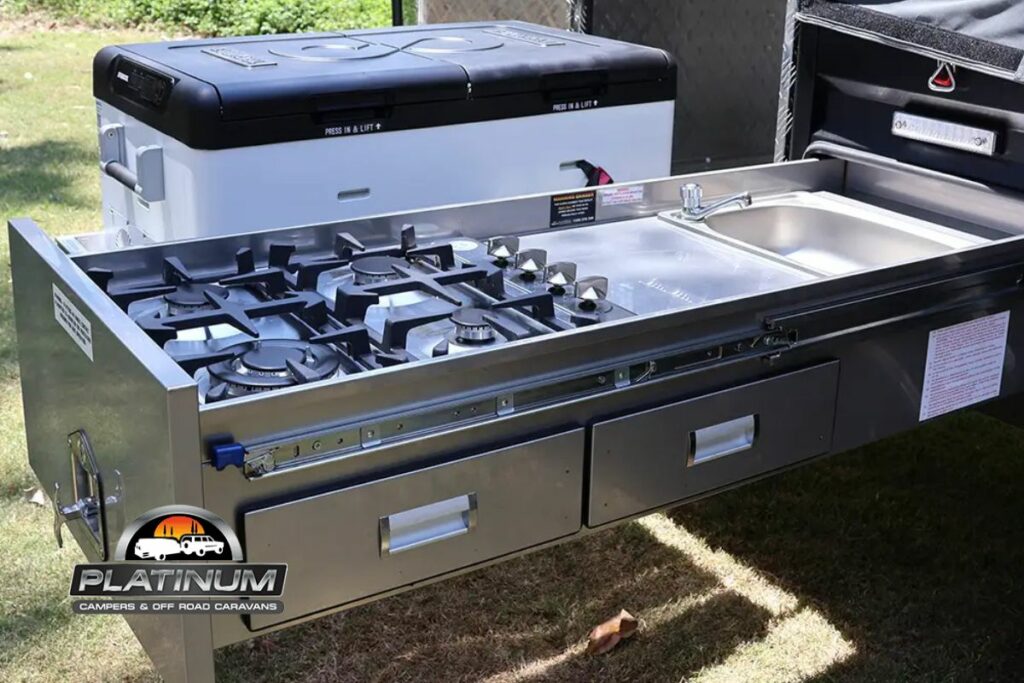
Digital Organisation Systems
Modern camping benefits significantly from digital organisation tools that streamline planning and execution. Develop comprehensive packing checklists using smartphone apps that sync across devices. This ensures nothing is forgotten and allows multiple family members to contribute to packing preparation.
Photo documentation creates valuable references for future trips. Photograph your packed camper from multiple angles, showing efficient storage solutions and setup configurations. These visual references speed up future packing and help identify optimal arrangements through trial and refinement.
GPS tracking and campsite documentation help plan future adventures and share successful locations with other campers. Many experienced campers maintain detailed digital logs including campsite coordinates, facility information, and recommended routes. This information becomes invaluable for planning return visits and sharing recommendations with fellow enthusiasts.
Community Resources and Networks
Australian camping communities provide exceptional resources for rear fold camper owners. Online forums specific to your camper brand offer troubleshooting advice, modification ideas, and experienced user insights. Participating in these communities accelerates your learning and provides support for challenging situations.
Local camping clubs often organise events specifically for camper trailer enthusiasts. These gatherings provide opportunities to observe different setup techniques, learn from experienced users, and discover innovative modifications. Many successful campers attribute their expertise to knowledge gained through community participation.
Manufacturer support extends beyond warranty coverage to include setup training, maintenance guidance, and modification advice. Establish relationships with dealership service departments and take advantage of owner training opportunities. Many manufacturers offer specialised clinics that address specific model features and optimal usage techniques.
Frequently Asked Questions
How long should setup take for a rear fold camper trailer? With practice, most rear fold campers can be set up in 15-20 minutes. Initial setups may take 45-60 minutes while learning the system, but efficiency improves rapidly with experience.
What’s the best way to pack heavy items in a lightweight camper? Position heavy items low and central, maintaining 60% weight forward of the axle. Distribute weight evenly side-to-side and secure all items to prevent movement during travel.
How often should I lubricate the folding mechanism? Lubricate hinge points and gas struts monthly during active use periods, or every 3-4 trips. More frequent lubrication may be needed in dusty or sandy conditions.
Can I set up my rear fold camper on uneven ground? Yes, but use stabilizer legs to level the camper before unfolding. Significant slopes may require leveling blocks or repositioning to ensure proper operation and comfort.
What should I do if my gas struts stop working? Support the fold mechanism with temporary props and inspect struts for damage. Clean and lubricate rod sections first, as this resolves many apparent failures. Replace if problems persist.
How do I prevent canvas damage during setup? Follow the correct setup sequence, avoid forcing zippers, and ensure adequate tension without overstretching. Clean zippers regularly and store canvas completely dry to prevent deterioration.
What tools should I carry for field maintenance? Pack adjustable spanners, cable ties, replacement springs, canvas repair patches, lubricant spray, and basic electrical supplies. A good LED headlamp is essential for low-light situations.
How do I maximise storage space in a compact camper? Use vertical storage solutions, modular packing systems, and vacuum storage bags for clothing. Position frequently used items in easily accessible locations while maintaining proper weight distribution.
What’s the difference between rear fold and forward fold campers? Rear fold campers unfold away from the towing vehicle, providing better privacy and access. They typically offer quicker setup and easier packing than forward fold designs. For detailed comparisons, see our hard floor camper guide.
Should I cover my camper during extended storage? Yes, use breathable covers that protect from UV and dust while allowing moisture ventilation. Ensure the camper is clean and completely dry before covering to prevent mould and mildew.
Sources
- Caravan Industry Association of Australia – Safety and Setup Guidelines
- Australian Government Department of Transport – Trailer Towing Regulations
- Bureau of Meteorology – Seasonal Weather Patterns for Camping
- Standards Australia – Recreational Vehicle Safety Standards
- Queensland Government – National Parks Camping Guidelines
Explore Platinum Campers’ Rear Fold Range Today
Ready to experience the convenience and reliability of a lightweight rear fold camper trailer? Discover Platinum Campers’ exceptional Chase S5 and Quest E1 models, engineered specifically for Australian conditions and designed to make your camping adventures effortless and enjoyable. Visit our showrooms in Townsville, Rockhampton, Brisbane, or Cairns to see these innovative campers in person and speak with our experienced team about finding the perfect model for your needs.


